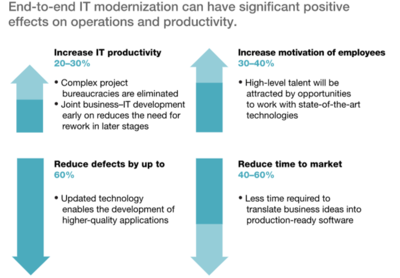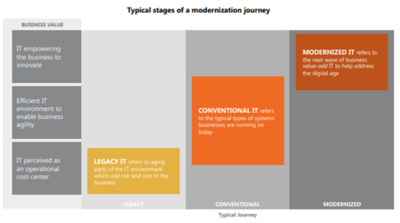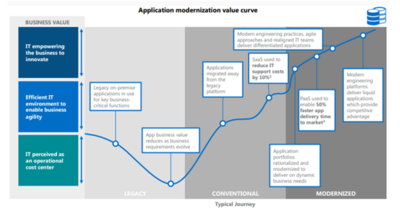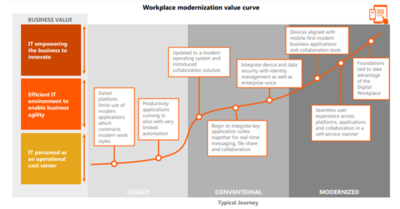IT Modernization
What is Information Technology Modernization?
Information Technology Modernization or IT Modernization is the refactoring, re-purposing or consolidation of legacy IT Capability to align it more closely with current business needs. All aspects of an organization's IT Operations, Enterprise Architecture and Organization are assessed, evaluated, remodeled, and modified as needed. The goal of an IT Modernization Project is to:
- Align IT Capability with Business Needs
- Reduce the cost of IT Operations
- Introduce new technologies into the organization
- Refresh IT skills
While the IT modernization definition varies across businesses, industries, and personas, it ultimately is the leveraging of technology to meet changing and expanding business goals. It means the alignment of IT and business to compete in the current day digital economy. It means the digitalization and Customer Experience Management (CEM)improvement in the customer experience]] to elevate service levels and create market differentiation.
== Approaches to IT Modernization[1]
Most companies face critical IT modernization issues, whether that means digitizing the customer purchasing experience, managing or moving away from aging software and hardware solutions, or shifting to newer technologies such as cloud-based computing, serverless computing, and microservices for delivering software.
- Incremental Approach to IT Modernization: Historically, companies have favored an incremental approach to modernizing IT—that is, addressing the most immediate points of pain and then subsequent issues as they occur. However, the threat of digital disruption is creating an urgent need for companies to modernize IT systems end to end, with the big picture in mind. Certainly, the long-favored incremental approach to modernization may entail fewer risks: if something goes awry on a small software-development project, the harm from bugs or faulty processes can be contained and resolved before widespread issues occur. Incrementalism can also offer short-term improvements faster: through small service- or product-line changes, companies may be able to realize quick benefits in, say, customer interfaces or tasks associated with systems maintenance. But incrementalism can also limit companies’ growth and competitiveness in some important ways. Under this approach, technology teams in different parts of the IT organization may independently address discrete systems questions involving their own areas of competence or internal business clients. They may create islands of solutions, which in turn may breed more complexity, while redundant systems and processes remain. And when companies inevitably pursue digital initiatives, weaknesses in their traditional product-development processes and IT-management systems can be exposed. Customers may experience this as missing data links, slow processing speeds, and disconnected products and services.
- End-to-End IT Modernization Approach: End-to-end modernization, or a holistic approach to tackling system upgrades, completely redefines how a company thinks about IT. Under this approach, the technology organization is no longer just a shared service; IT becomes a critical part of the company’s DNA, and IT leaders become trusted partners, not just service providers. The end-to-end approach to modernizing IT is more effective for creating and supporting viable digital businesses (see figure below). To pursue this approach, executives must break down the change process into three critical steps: defining the target state for their IT architectures, deciding which elements of the IT landscape (systems, people, and processes) need to change, and determining the sequence and scope of change. We’ve seen some companies tackle each of these steps in isolation, often in the context of a business-unit request for a new technology-enabled feature. But relatively few companies are considering these three steps in systematic fashion, across all business units and functions, and with input from both IT professionals and business leaders.
Compared with incrementalism, the end-to-end path toward a modern IT landscape can be more risky, and potentially more expensive. In most cases, however, avoiding duplicate work leads to lower costs. It may pave the way for seamless adoption of microservices, two-speed IT, and other emerging approaches for managing and enhancing IT architecture. And, ultimately, end-to-end modernization may ensure that companies have the right IT capabilities for decades rather than just the next few years.
Stages of IT Modernization[2]
The type of journey you take to a modernized IT environment depends on factors including what your environment looks like today and what challenges you need to confront in order to modernize. Most companies start out from a legacy or conventional IT IT that adds risk and cost to the business – such as unsupported or non-strategic hardware or software.
The conventional IT environment typically includes some legacy business agility – and even some components for innovation. The modernized IT environment is the destination for the company seeking to implement a digital transformation. Its technologies, tools and approaches not only add value to the business, but also empower innovation to meet the many demands of stakeholders and to help the company thrive in an increasingly competitive and resource-challenged environment. IT modernization is a holistic process that touches on every aspect of the IT environment. But that can be an enormous and intimidating prospect, so let’s break it down into three manageable components that every company should consider: application, infrastructure and workplace modernization.
- Application Modernization: For your applications to perform faster, scale higher and operate with greater flexibility than before, you should consider modernizing them with a cloud-first, mobile-first approach. You want agile, micro-engineered, liquid applications that are quickly assembled, delivered as-a-service, highly reliable, and easy to maintain and update. It’s likely that business applications in the legacy environment were fit for purpose when adopted but their value drops as business requirements moves to the digital age. companies tend to move their applications onto updated on-premises systems or lift-and-shift them to the cloud using infrastructure-as-a-service – both of which constitute more conventional IT options. This helps to the extent that the new platform is more scalable and less risky. But it’s also like moving the same old car into a fancier garage – nothing essential has changed, so the gains are modest. Platform-as-a-service can in some cases cut application delivery time-to-market in half and generate a five year ROI of 466%, giving IT teams even more ability to innovate, experiment, and create differentiated value and competitive advantage. DevOps and agile are two practices that contribute to these gains. Gartner says they are proving as disruptive to IT as lean was to manufacturing in the 1980s.
- Infrastructure Modernization – Modernized applications typically drive the modernization of the infrastructure. Achieving the speed, scalability and reliability that you want from your applications depends on modernizing legacy infrastructure into flexible, hybrid and automated environments. Like application modernization, the journey to infrastructure modernization begins with infrastructure originally fit for purpose, which loses business value as demands on it increase. As the infrastructure is refreshed on premises with optimized hardware and virtualization, the environment evolves to what we’ve called conventional infrastructure. For the enterprise that adopts the cloud, infrastructure is quickly modernized and business value quickly grows. Cloud infrastructure reduces deployment time from weeks to hours. Unified identity systems move to the cloud, enabling connected ecosystems with business partners. A seamless hybrid infrastructure emerges, aided by processes and teams that leverage DevOps to further forge a single, transparent unit. As the infrastructure is further modernized, IT teams use infrastructure as code, automated provisioning, monitoring and self-healing – sending business value soaring. The journey to infrastructure modernization is real and happening now. About 80% of IT organizations were set to commit to hybrid cloud by 2017 . And 60% of enterprises use DevOps or plan to do so within two years from then.
- Workplace Modernization – Your transition to a digital business will increasingly demand that you empower employees with connected collaboration tools to work smarter. Modernizing your legacy workplace environment is the first step toward attaining a truly digital workplace that makes empowerment possible. Once you update or replace the workplace tools, you can then proceed to transform the business processes that use them. In the legacy environment, an outdated platform or operating system limits the use of modern applications and constrains modern workstyles. In a conventional workplace environment, typically organizations have introduced various collaboration technologies. Though, at this stage these technologies, such as real-time messaging, file share and collaboration are often disparate, and so business agility is limited. As the workplace is further modernized, business and collaboration applications are fully integrated and are aligned with devices, with mobile versions ready and mobile workers fully enabled. Workers gain a seamless experience across platforms and applications, and self-service portals are in place for most user requirements, such as application access. The workplace environment is dynamic and immersive, and the foundations are set to take advantage of the Digital Workplace. Workplace modernization is well underway. By 2020, 60% of business users will be provisioned at least in part with office system capabilities from the cloud, according to Gartner.
While breaking down IT modernization into these three major areas is useful for clarity, they should be thought of holistically to multiply the effect of IT modernization. For example, a journey in which each of the three modernization components supports the others can speed the process, enabling the enterprise to jump over some intermediate steps. The holistic approach also requires the business to think about the order in which component journeys are planned and implemented. For example, infrastructure exists to support applications, not the other way around, so the application modernization should be planned first - but implemented second.
Examples of IT Modernization[3]
Today’s businesses can modernize in variety of ways and for a variety of reasons. Some of the most common in 2018 include:
- ERP replacement: Electronic Resource Planning systems are the information backbone of most companies, and upgrading to a new solution (whether cloud-based or on-premise) is increasingly common as more ERP products that better align to a company’s vision hit the market.
- AS/400 decommissioning: The IBM iSeries AS/400 has been a highly dependable software solution across industries for decades, but a lack of product knowledge and integration capabilities have many companies phasing it out in favor of a more modern, user-friendly platform.
- Mergers and acquisitions/divestitures: When businesses merge, a whole bunch of systems and processes come together under one proverbial roof, and the business often chooses to consolidate many of them onto a single integration platform. Conversely, when a divestiture happens, one or more of the divested organizations may be left without a proper EDI technology (and its associated resources), for example, and have to procure and implement a managed-service solution.
- Replacing a legacy EDI solution: The standardized EDI format and digital file transfer transformed B2B communications when it replaced paper documents, and EDI still very much drives global commerce today. But many aging EDI solutions, including EDI VANs, cannot deliver the modern governance, visibility, and integration capabilities in a cost-effective way that supports such important revenue-generating data flows.
- Migrating homegrown integration tools: The custom-built solutions that facilitate your data flows are too often pieced together by layers of hand code that is development-intensive, hinders partner onboarding, and limits scalability and growth. Modern B2B integration platforms provide out-of-the-box functionality so you spend less time managing the data minutiae and more time managing your core business functions.
See Also
- Application Modernization
- Application Modernization Services
- IT Cost Optimization
- Business IT Alignment
- IT Transformation
- IT Strategic Plan (Information Technology Strategic Plan)
- IT Strategic Planning
- IT Strategy (Information Technology Strategy)
- IT Governance
- Enterprise Architecture Life Cycle (EALC)
- Enterprise Architecture
- IT Operating Model
- IT Operations (Information Technology Operations)





